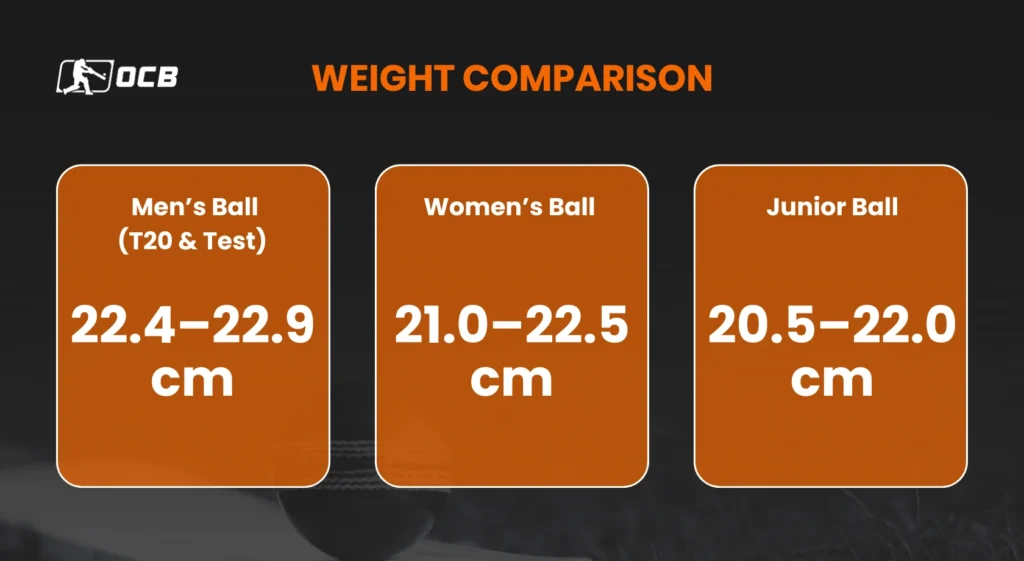What is the Weight of a Cricket Ball: Facts vs Common Myths
Written by: OCB Editorial Team • 22.07.2025

If you've ever held a cricket ball, you know it's more than just a piece of leather - it's the heart of the game. But how much does a cricket ball actually weigh? And why does it matter?
The weight of a cricket ball plays a crucial role in how the game unfolds. From swing and spin to bounce and balance, the ball’s weight affects both bowlers and batters. Whether it’s a red ball under the sun in a five-day Test or a white one flying under lights in a T20, different formats rely on subtle differences in the ball’s construction and performance.
Yet, there’s a lot of confusion out there. In this guide, we’ll break down the facts, bust common myths, and explain everything you need to know about cricket ball weight, including official standards, variations by format, and what makes each type of ball unique. Let’s dive in.
Construction and Materials of a Cricket Ball
To understand what is the weight of cricket ball, you first need to know how it’s made. Each ball is crafted to meet exact specifications; however, there are always variations with a handmade product. The type of leather being used, the skill of the workers, the stitching, the kind of cork and everything else can have an effect, which is why you may have heard a lot of complaining about the batch of "soft" balls used for the England vs India series.
Even the ball manufacturer has agreed that the batch of balls provided are softer and last less than they would expect. Oh, and cricket uses multiple ball manufacturers (that use different processes) which also leads to variation among the cricket balls. The weight, though, falls within a set range.
A standard cricket ball consists of a core made from compressed cork, which is tightly wound with layers of string to form a dense, solid interior. This core gives the ball its basic weight and shape retention.
The outer layer is made of high-quality leather, dyed and treated for durability and water resistance. Two hemispherical pieces of leather are stitched together around the core using six rows of prominent seam stitching. The stitching isn’t just structural, it directly impacts how the ball moves in the air and off the pitch.
The materials, winding density, leather thickness, and seam alignment all combine to make the ball meet regulated standards. These elements add up to the final cricket ball weight and influence how it behaves throughout a match.
Cork Core and String Winding Process
At the heart of every cricket ball is a small cork core. The winding around the core isn’t random, it’s actually a finely-tuned process that affects how the ball travels through the air. More tightly wound balls generally last longer and are more predictable.
Leather Cover and Seam Stitching (6 Rows)
Wrapped around the cork core is a tough leather cover, dyed traditionally in red, white, or pink depending on the match format. The stitching involves six rows of seam, which not only holds the leather together but also aids bowlers in generating swing and seam movement.
A fresh seam can be deadly in the hands of a skilled bowler, something to keep in mind next time you’re checking cricket betting odds during a match’s early overs.
British Standard BS 5993 Specifications
All professional cricket balls are made according to the British Standard BS 5993, a specification that outlines acceptable cricket ball weight, shape, bounce, and construction quality. Any deviation from this standard is unacceptable in international or domestic pro-level games.
Expert Perspective
Our expert Cricket Analyst Dhruv at OCBscores.com tells us his take on cricket ball weight:
"When we talk about ball weight, most fans think it’s just for show. But honestly, betting strategies change based on the kind of ball in-play. A white ball in a T20 could swing differently under lights than a red ball during the day, a pink ball behaves differently altogether, and knowing that helps you read conditions better. For punters, it’s not just trivia, it’s vital information."
Official Weight and Size Standards by Category
The weight of a cricket ball varies slightly depending on the format of the game – be it men’s, women’s, or junior cricket - as well as the age group of the players involved. However, all professional and competitive matches must adhere to strict regulations defined by the official cricket boards to maintain fairness and consistency .
These standards cover not only the ball’s weight but also its circumference, bounce, and seam height. Even a few grams of difference can influence the ball’s behaviour in the air or off the pitch, affecting pace, swing, spin, and durability.
This is why balls used in international fixtures must fall within precise limits, which manufacturers follow under approved quality control procedures.
Understanding these categories is essential when comparing how the game plays out across men’s and women’s formats, or when analysing performance in T20s versus Tests.
Men’s Cricket Ball Weight: 156–163g
This is the standard range used in all professional men’s formats: Tests, ODIs, and T20s. The official international cricket ball weight is around 156 grams, but the allowable variance can take it up to 163 grams.
A heavier ball can offer less swing but more bounce, while a slightly lighter one may help reverse swing and spin.
Women’s Cricket Ball Weight: 140–151g
Women’s matches use a lighter ball, averaging 142 grams. This means better control, more spin, and improved game dynamics suitable for the pace and strength of female players.
This detail matters if you’re betting on women’s cricket; knowing how a lighter ball reacts can influence your strategy.
Junior Cricket Ball Weight: 133–143g
For under-13 and under-15 games, even lighter balls are used to help young players develop technique without risking injury. These don’t meet full international cricket ball weight criteria, but they're important in grassroots cricket.

Join our cricket betting community
Follow us on social media to stay up to date!
Circumference and Diameter Guidelines
Along with weight, circumference is closely monitored.
- Men’s Ball: 22.4–22.9 cm
- Women’s Ball: 21.0–22.5 cm
- Junior Ball: 20.5–22.0 cm
This uniformity lets bowlers and batters adapt quickly when moving between levels or formats.
T20 Cricket Ball Weight vs Test Ball Weight
Here’s a fun myth-buster: T20 cricket ball weight is exactly the same as Test cricket. The difference lies in the color, the ball treatment (coats of lacquer), and brand preferences. Some manufacturers slightly tweak seam prominence for better grip under lights, but the T20 cricket ball weight remains within the standard 156–163g range.

Types of Cricket Balls and Their Uses
Understanding the type of ball in play is crucial, as it directly influences how the match unfolds, whether you're watching a Test match, an ODI, or a T20. Different formats use different types of cricket balls, each designed for specific conditions, visibility, and durability. The choice of ball can affect swing, spin, bounce, and even how quickly the ball deteriorates over time.
For example, red balls are traditionally used in Test cricket for their ability to retain shape and shine over long periods. In contrast, white balls are more visible under floodlights and are preferred in limited-overs formats like ODIs and T20s. Then there are pink balls (used for Day-Night Test Matches) synthetic balls, and specialised training balls, which are all designed with particular goals in mind.
Whether you're analysing player performance or exploring the top cricket betting sites, if you know how each ball behaves, it will help you better understand the game’s dynamics and make more informed predictions.
Red Ball: Test Matches and Durability
The red ball is traditional, used in Test cricket and first-class matches. It's designed for longer play, offering solid durability and a prominent seam for extended swing and seam movement.
It’s also rougher in texture, which bowlers love, especially when trying to get late reverse swing.
White Ball: Limited Overs and Visibility
Used in ODIs and T20s, the white ball is made to be visibile under floodlights and against coloured clothing. However, it wears out faster and loses swing early, making death overs more predictable; crucial info when placing bets on run totals.
Pink Ball: Day-Night Test Matches
This is relatively new but growing fast. The pink ball is used in day-night Tests for better visibility and enhanced swing. It retains shine longer, making middle sessions more lively for bowlers. Keep an eye on pink-ball fixtures; they can be full of surprises.
Training Balls: Incrediball and Wind Ball
Incrediballs are softer, with a leather-like finish but safer for beginners. Wind balls are hollow, rubbery options used in practice or gully cricket. These don’t follow cricket ball weight standards but are helpful for training without injuries.
Synthetic and Rubber Ball Alternatives
For turf-less pitches or rainy days, rubber and synthetic balls come into play. Though not used professionally, they’re great for casual matches and maintaining form in off-season conditions.
Impact of Ball Condition on Performance
Even if two balls weigh the same, their condition can drastically change how they perform, and how players use them strategically.
Swing and Seam Movement with New vs Old Ball
A brand-new ball swings more, especially if the seam is prominent. This is why captains often start with pace bowlers. But as the ball ages, it becomes more batter-friendly; unless you know how to shine it right.
Reverse Swing and Ball Shining Rules
When one side of the ball is kept shiny while the other wears out, it begins to reverse swing, especially in subcontinental heat. Maintaining that shine legally is an art. Betting tip: If the bowlers are reverse-swing specialists, expect late-game wickets.
Ban on Saliva and Legal Ball Maintenance
Since the pandemic, players can no longer use saliva to shine the ball. Only sweat is allowed, reducing swing potential. This change has quietly influenced match dynamics, especially in longer formats.
Ball Tampering Laws and Penalties
Scratching, biting, or altering the ball with foreign objects is illegal. Players caught face bans, fines, and match suspensions. Knowing this helps bettors avoid matches with uncertainty due to mid-match controversies.
Conclusion
So, now you know what is the weight of cricket ball, how it's made, and why it matters, not just for players, but for smart bettors like you. From red to pink, junior to T20, understanding the cricket ball weight opens up a new layer of insight into the sport.
Next time you're watching cricket or placing cricket bets, consider the ball type, condition, and format. These subtle cues can be the difference between a good bet and a great one.
For deeper insights into match tactics and betting smarter, explore our full Cricket Guides with tips and how-to guidance from our in-house team of experts.
FAQs
The T20 cricket ball weight is the same as other men’s formats - 156 to 163 grams.
Yes, women’s cricket uses balls weighing between 140 and 151 grams.
Absolutely. Ball type affects swing, scoring patterns, and match pace, all of which influence cricket betting odds.
For men’s matches, the international cricket ball weight is 156–163 grams.
No. Synthetic or rubber balls are only used in training or casual games.